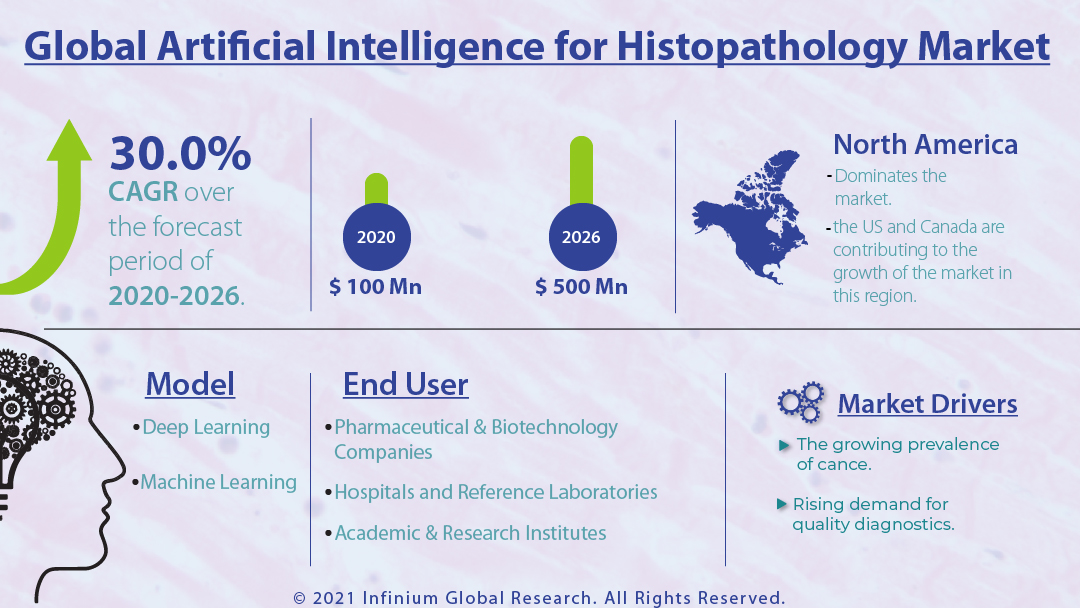Artificial Intelligence for Histopathology Market (Model - Deep Learning, and Machine Learning; End User - Pharmaceutical & Biotechnology Companies, Hospitals and Reference Laboratories, and Academic & Research Institutes): Global Industry Analysis, Trends, Size, Share and Forecasts to 2026
A recent report published by
Infinium Global Research on artificial intelligence for histopathology market
provides in-depth analysis of segments and sub-segments in the global as well
as regional artificial intelligence for the histopathology market. The study also
highlights the impact of drivers, restraints, and macro indicators on the
global and regional artificial intelligence for histopathology market over the
short term as well as long term. The report is a comprehensive presentation of
trends, forecast and dollar values of global artificial intelligence for
histopathology market. According to the report, the global artificial
intelligence for histopathology market was nearly worth USD 100 million in 2020
and is expected to reach USD 500 Million by 2026, growing with a CAGR of 30%
over the forecast period of 2020-2026.
Market Insight
Histopathology is a gold standard
for disease diagnosis, and advances in artificial intelligence will increase
the accuracy of this technique. Artificial intelligence for histopathology can
be applied to detect and count cells. It can also be applied to detect
segmentation and classify tissues whether it is healthy or diseased. A key
benefit of such artificial technology is that it can be applied to whole slide
imaging, where the AI can automatically identify patterns in a whole slide.
The pandemic has had a significant
impact on clinical services, including cancer pathways. Pathologists are
working remotely in many circumstances to protect themselves, colleagues, and
the delivery of clinical services. The effects of COVID-19 on research and
clinical trials have also been significant with changing protocols. Pathology
is a vital part of cancer and other diagnostic pathways, being a core component
in 70% of clinical interventions. A prior to the COVID-19 pandemic,
histopathology capacity was not keeping pace with year-on-year increases in
demand. In this case, AI gaining traction. There are several AI tools on the
‘roadmap’ to full diagnostic use and some have regulatory clearance too. With
further evidence, AI could provide double reporting such as has been outlined
as a possibility in mammography screening, providing resilience to services
when pathologists are not available, and creating further efficiency gains.
AI-based computational histopathology increases both the accuracy and
availability of high-quality health care to patients in many medical fields.
The primary forces and limitations in this field are a shortage of experienced
pathologists and the limitation of global health care resources.
AI has the ability to handle the
gigantic quantity of data created throughout the patient care lifecycle to
improve pathologic diagnosis, classification, prediction, and prognostication
of diseases. Histopathology is the cornerstone of cancer care. The need for
accuracy in the histopathologic diagnosis of cancer is increasing as
personalized cancer therapy requires accurate biomarker assessment. The
integration of machine learning into routine care will be a milestone for the
healthcare sector, and histopathology is right at the center of this
revolution. Recent studies have demonstrated that applications of machine
learning in pathology significantly improves metastases detection in lymph
nodes, Ki67 scoring in breast cancer, Gleason grading in prostate cancer, and
tumor-infiltrating lymphocyte (TIL) scoring in melanoma. With continual
innovation in AI-based pathologies, AI could detect 0.2mm tumors or tumors made
up of less than 200 cells. The research found that a deep learning system has
achieved an accuracy rate of 0.7 in comparison to 0.61 by pathologists.
However, data sets for learning are expensive, again there is a risk of bias
from the training data and no transparency into the decision process which
affects the growth of the market. Moreover, technological advancement in AI for
histopathology will provide a significant growth opportunity for the market.
North America dominates the
artificial intelligence for the histopathology market. The growing prevalence
of cancer, rising demand for quality diagnostics, the introduction of favorable
reimbursement policies, and the implementation of favorable initiatives by the
government in the US and Canada are contributing to the growth of the market in
this region.

Segment Covered
The report on global artificial
intelligence for histopathology market covers segments such as model, and end
user. On the basis of model, the sub-markets include deep learning, and machine
learning. On the basis of end user, the sub-markets include pharmaceutical
& biotechnology companies, hospitals and reference laboratories, and
academic & research institutes.
Companies Profiled:
The report provides profiles of
the companies in the market such as ContextVision, Proscia, Koninklijke Philips
N.V, Hamamatsu Photonics, Leica Biosystems, Roche, 3DHISTECH, Apollo Enterprise
Imaging, Huron Digital Pathology, and Visiopharm A/S.
Report Highlights:
The report provides deep insights
into the demand forecasts, market trends, and micro and macro indicators. In
addition, this report provides insights into the factors that are driving and
restraining the growth in this market. Moreover, The IGR-Growth Matrix analysis
given in the report brings an insight into the investment areas that existing
or new market players can consider. The report provides insights into the
market using analytical tools such as Porter's five forces analysis and DRO analysis
of artificial intelligence for histopathology market. Moreover, the study
highlights current market trends and provides forecast from 2020-2026. We also
have highlighted future trends in the market that will affect the demand during
the forecast period. Moreover, the competitive analysis given in each regional
market brings an insight into the market share of the leading players.
